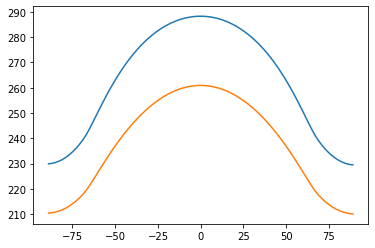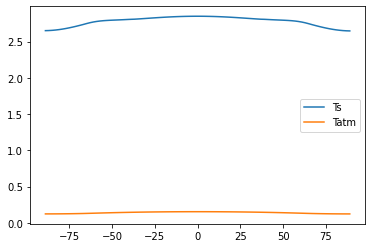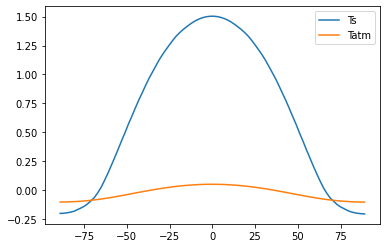Polar amplification in simple models¶
[1]:
%matplotlib inline
import numpy as np
import matplotlib.pyplot as plt
import climlab
from climlab import constants as const
EBM with surface and atm layers¶
[2]:
ebm = climlab.GreyRadiationModel(num_lev=1, num_lat=90)
insolation = climlab.radiation.AnnualMeanInsolation(domains=ebm.Ts.domain)
ebm.add_subprocess('insolation', insolation)
ebm.subprocess.SW.flux_from_space = ebm.subprocess.insolation.insolation
print(ebm)
climlab Process of type <class 'climlab.model.column.GreyRadiationModel'>.
State variables and domain shapes:
Ts: (90, 1)
Tatm: (90, 1)
The subprocess tree:
Untitled: <class 'climlab.model.column.GreyRadiationModel'>
LW: <class 'climlab.radiation.greygas.GreyGas'>
SW: <class 'climlab.radiation.greygas.GreyGasSW'>
insolation: <class 'climlab.radiation.insolation.AnnualMeanInsolation'>
[3]:
# add a fixed relative humidity process
# (will only affect surface evaporation)
h2o = climlab.radiation.ManabeWaterVapor(state=ebm.state, **ebm.param)
ebm.add_subprocess('H2O', h2o)
[4]:
# Add surface heat fluxes
shf = climlab.surface.SensibleHeatFlux(state=ebm.state, Cd=3E-4)
lhf = climlab.surface.LatentHeatFlux(state=ebm.state, Cd=3E-4)
# couple water vapor to latent heat flux process
lhf.q = h2o.q
ebm.add_subprocess('SHF', shf)
ebm.add_subprocess('LHF', lhf)
[5]:
ebm.integrate_years(1)
Integrating for 365 steps, 365.2422 days, or 1 years.
Total elapsed time is 0.9993368783782377 years.
[6]:
plt.plot(ebm.lat, ebm.Ts)
plt.plot(ebm.lat, ebm.Tatm)
[6]:
[<matplotlib.lines.Line2D at 0x16b2f2730>]

[7]:
co2ebm = climlab.process_like(ebm)
co2ebm.subprocess['LW'].absorptivity = ebm.subprocess['LW'].absorptivity*1.1
[8]:
co2ebm.integrate_years(3.)
Integrating for 1095 steps, 1095.7266 days, or 3.0 years.
Total elapsed time is 3.997347513512951 years.
[9]:
# no heat transport but with evaporation -- no polar amplification
plt.plot(ebm.lat, co2ebm.Ts - ebm.Ts)
plt.plot(ebm.lat, co2ebm.Tatm - ebm.Tatm)
[9]:
[<matplotlib.lines.Line2D at 0x16b42a130>]

Now with meridional heat transport¶
[10]:
diffebm = climlab.process_like(ebm)
# thermal diffusivity in W/m**2/degC
D = 0.6
# meridional diffusivity in m**2/s
K = D / diffebm.Tatm.domain.heat_capacity * const.a**2
d = climlab.dynamics.MeridionalDiffusion(K=K, state={'Tatm': diffebm.Tatm}, **diffebm.param)
diffebm.add_subprocess('diffusion', d)
print(diffebm)
climlab Process of type <class 'climlab.model.column.GreyRadiationModel'>.
State variables and domain shapes:
Ts: (90, 1)
Tatm: (90, 1)
The subprocess tree:
Untitled: <class 'climlab.model.column.GreyRadiationModel'>
LW: <class 'climlab.radiation.greygas.GreyGas'>
SW: <class 'climlab.radiation.greygas.GreyGasSW'>
insolation: <class 'climlab.radiation.insolation.AnnualMeanInsolation'>
H2O: <class 'climlab.radiation.water_vapor.ManabeWaterVapor'>
SHF: <class 'climlab.surface.turbulent.SensibleHeatFlux'>
LHF: <class 'climlab.surface.turbulent.LatentHeatFlux'>
diffusion: <class 'climlab.dynamics.meridional_advection_diffusion.MeridionalDiffusion'>
[11]:
diffebm.integrate_years(3)
Integrating for 1095 steps, 1095.7266 days, or 3 years.
Total elapsed time is 3.997347513512951 years.
[12]:
plt.plot(diffebm.lat, diffebm.Ts)
plt.plot(diffebm.lat, diffebm.Tatm)
[12]:
[<matplotlib.lines.Line2D at 0x16b4a7f40>]

[13]:
def inferred_heat_transport( energy_in, lat_deg ):
'''Returns the inferred heat transport (in PW) by integrating the net energy imbalance from pole to pole.'''
from scipy import integrate
from climlab import constants as const
lat_rad = np.deg2rad( lat_deg )
return ( 1E-15 * 2 * np.math.pi * const.a**2 * integrate.cumtrapz( np.cos(lat_rad)*energy_in,
x=lat_rad, initial=0. ) )
[14]:
# Plot the northward heat transport in this model
Rtoa = np.squeeze(diffebm.timeave['ASR'] - diffebm.timeave['OLR'])
plt.plot(diffebm.lat, inferred_heat_transport(Rtoa, diffebm.lat))
[14]:
[<matplotlib.lines.Line2D at 0x16b5213d0>]

[15]:
## Now warm it up!
co2diffebm = climlab.process_like(diffebm)
co2diffebm.subprocess['LW'].absorptivity = diffebm.subprocess['LW'].absorptivity*1.1
[16]:
co2diffebm.integrate_years(5)
Integrating for 1826 steps, 1826.2110000000002 days, or 5 years.
Total elapsed time is 8.99676981465997 years.
[17]:
# with heat transport and evaporation
# Get some modest polar amplifcation of surface warming
# but larger equatorial amplification of atmospheric warming
# Increased atmospheric gradient = increased poleward flux.
plt.plot(diffebm.lat, co2diffebm.Ts - diffebm.Ts, label='Ts')
plt.plot(diffebm.lat, co2diffebm.Tatm - diffebm.Tatm, label='Tatm')
plt.legend()
[17]:
<matplotlib.legend.Legend at 0x16b592730>

[18]:
Rtoa = np.squeeze(diffebm.timeave['ASR'] - diffebm.timeave['OLR'])
Rtoa_co2 = np.squeeze(co2diffebm.timeave['ASR'] - co2diffebm.timeave['OLR'])
plt.plot(diffebm.lat, inferred_heat_transport(Rtoa, diffebm.lat), label='1xCO2')
plt.plot(diffebm.lat, inferred_heat_transport(Rtoa_co2, diffebm.lat), label='2xCO2')
plt.legend()
[18]:
<matplotlib.legend.Legend at 0x16b61b7f0>

Same thing but with NO EVAPORATION¶
[19]:
diffebm2 = climlab.process_like(diffebm)
diffebm2.remove_subprocess('LHF')
diffebm2.integrate_years(3)
co2diffebm2 = climlab.process_like(co2diffebm)
co2diffebm2.remove_subprocess('LHF')
co2diffebm2.integrate_years(3)
# With transport and no evaporation...
# No polar amplification, either of surface or air temperature!
plt.plot(diffebm2.lat, co2diffebm2.Ts - diffebm2.Ts, label='Ts')
plt.plot(diffebm2.lat, co2diffebm2.Tatm[:,0] - diffebm2.Tatm[:,0], label='Tatm')
plt.legend()
plt.figure()
# And in this case, the lack of polar amplification is DESPITE an increase in the poleward heat transport.
Rtoa = np.squeeze(diffebm2.timeave['ASR'] - diffebm2.timeave['OLR'])
Rtoa_co2 = np.squeeze(co2diffebm2.timeave['ASR'] - co2diffebm2.timeave['OLR'])
plt.plot(diffebm2.lat, inferred_heat_transport(Rtoa, diffebm2.lat), label='1xCO2')
plt.plot(diffebm2.lat, inferred_heat_transport(Rtoa_co2, diffebm2.lat), label='2xCO2')
plt.legend()
Integrating for 1095 steps, 1095.7266 days, or 3 years.
Total elapsed time is 6.995358148647664 years.
Integrating for 1095 steps, 1095.7266 days, or 3 years.
Total elapsed time is 11.994780449794684 years.
[19]:
<matplotlib.legend.Legend at 0x16b6fddf0>


A column model approach¶
[20]:
model = climlab.GreyRadiationModel(num_lev=30, num_lat=90, abs_coeff=1.6E-4)
insolation = climlab.radiation.AnnualMeanInsolation(domains=model.Ts.domain)
model.add_subprocess('insolation', insolation)
model.subprocess.SW.flux_from_space = model.subprocess.insolation.insolation
print(model)
climlab Process of type <class 'climlab.model.column.GreyRadiationModel'>.
State variables and domain shapes:
Ts: (90, 1)
Tatm: (90, 30)
The subprocess tree:
Untitled: <class 'climlab.model.column.GreyRadiationModel'>
LW: <class 'climlab.radiation.greygas.GreyGas'>
SW: <class 'climlab.radiation.greygas.GreyGasSW'>
insolation: <class 'climlab.radiation.insolation.AnnualMeanInsolation'>
[21]:
# Convective adjustment for atmosphere only
conv = climlab.convection.ConvectiveAdjustment(state={'Tatm':model.Tatm}, adj_lapse_rate=6.5,
**model.param)
model.add_subprocess('convective adjustment', conv)
[22]:
# add a fixed relative humidity process
# (will only affect surface evaporation)
h2o = climlab.radiation.water_vapor.ManabeWaterVapor(state=model.state, **model.param)
model.add_subprocess('H2O', h2o)
[23]:
# Add surface heat fluxes
shf = climlab.surface.SensibleHeatFlux(state=model.state, Cd=1E-3)
lhf = climlab.surface.LatentHeatFlux(state=model.state, Cd=1E-3)
lhf.q = model.subprocess.H2O.q
model.add_subprocess('SHF', shf)
model.add_subprocess('LHF', lhf)
[24]:
model.integrate_years(3.)
Integrating for 1095 steps, 1095.7266 days, or 3.0 years.
Total elapsed time is 2.998010635134713 years.
[25]:
def plot_temp_section(model, timeave=True):
fig = plt.figure()
ax = fig.add_subplot(111)
if timeave:
field = model.timeave['Tatm'].transpose()
else:
field = model.Tatm.transpose()
cax = ax.contourf(model.lat, model.lev, field)
ax.invert_yaxis()
ax.set_xlim(-90,90)
ax.set_xticks([-90, -60, -30, 0, 30, 60, 90])
fig.colorbar(cax)
[26]:
plot_temp_section(model, timeave=False)

[27]:
co2model = climlab.process_like(model)
co2model.subprocess['LW'].absorptivity = model.subprocess['LW'].absorptivity*1.1
[28]:
co2model.integrate_years(3)
Integrating for 1095 steps, 1095.7266 days, or 3 years.
Total elapsed time is 5.996021270269426 years.
[29]:
plot_temp_section(co2model, timeave=False)

[30]:
# Without transport, get equatorial amplification
plt.plot(model.lat, co2model.Ts - model.Ts, label='Ts')
plt.plot(model.lat, co2model.Tatm[:,0] - model.Tatm[:,0], label='Tatm')
plt.legend()
[30]:
<matplotlib.legend.Legend at 0x16bf71ee0>

Now with meridional heat tranpsort!¶
[31]:
diffmodel = climlab.process_like(model)
[32]:
# thermal diffusivity in W/m**2/degC
D = 0.05
# meridional diffusivity in m**2/s
K = D / diffmodel.Tatm.domain.heat_capacity[0] * const.a**2
print(K)
5946637.413346613
[33]:
d = climlab.dynamics.MeridionalDiffusion(K=K, state={'Tatm':diffmodel.Tatm}, **diffmodel.param)
diffmodel.add_subprocess('diffusion', d)
print(diffmodel)
climlab Process of type <class 'climlab.model.column.GreyRadiationModel'>.
State variables and domain shapes:
Ts: (90, 1)
Tatm: (90, 30)
The subprocess tree:
Untitled: <class 'climlab.model.column.GreyRadiationModel'>
LW: <class 'climlab.radiation.greygas.GreyGas'>
SW: <class 'climlab.radiation.greygas.GreyGasSW'>
insolation: <class 'climlab.radiation.insolation.AnnualMeanInsolation'>
convective adjustment: <class 'climlab.convection.convadj.ConvectiveAdjustment'>
H2O: <class 'climlab.radiation.water_vapor.ManabeWaterVapor'>
SHF: <class 'climlab.surface.turbulent.SensibleHeatFlux'>
LHF: <class 'climlab.surface.turbulent.LatentHeatFlux'>
diffusion: <class 'climlab.dynamics.meridional_advection_diffusion.MeridionalDiffusion'>
[34]:
diffmodel.integrate_years(3)
Integrating for 1095 steps, 1095.7266 days, or 3 years.
Total elapsed time is 5.996021270269426 years.
[35]:
plot_temp_section(diffmodel)

[36]:
# Plot the northward heat transport in this model
Rtoa = np.squeeze(diffmodel.timeave['ASR'] - diffmodel.timeave['OLR'])
plt.plot(diffmodel.lat, inferred_heat_transport(Rtoa, diffmodel.lat))
[36]:
[<matplotlib.lines.Line2D at 0x16c19f130>]

[37]:
## Now warm it up!
co2diffmodel = climlab.process_like(diffmodel)
co2diffmodel.subprocess['LW'].absorptivity = diffmodel.subprocess['LW'].absorptivity*1.1
[38]:
co2diffmodel.integrate_years(3)
Integrating for 1095 steps, 1095.7266 days, or 3 years.
Total elapsed time is 8.994031905404139 years.
[39]:
# With transport, get polar amplification...
# of surface temperature, but not of air temperature!
plt.plot(diffmodel.lat, co2diffmodel.Ts - diffmodel.Ts, label='Ts')
plt.plot(diffmodel.lat, co2diffmodel.Tatm[:,0] - diffmodel.Tatm[:,0], label='Tatm')
plt.legend()
[39]:
<matplotlib.legend.Legend at 0x16c212220>

[40]:
Rtoa = np.squeeze(diffmodel.timeave['ASR'] - diffmodel.timeave['OLR'])
Rtoa_co2 = np.squeeze(co2diffmodel.timeave['ASR'] - co2diffmodel.timeave['OLR'])
plt.plot(diffmodel.lat, inferred_heat_transport(Rtoa, diffmodel.lat), label='1xCO2')
plt.plot(diffmodel.lat, inferred_heat_transport(Rtoa_co2, diffmodel.lat), label='2xCO2')
[40]:
[<matplotlib.lines.Line2D at 0x16c10c760>]

Same thing but with NO EVAPORATION¶
[41]:
diffmodel2 = climlab.process_like(diffmodel)
diffmodel2.remove_subprocess('LHF')
print(diffmodel2)
climlab Process of type <class 'climlab.model.column.GreyRadiationModel'>.
State variables and domain shapes:
Ts: (90, 1)
Tatm: (90, 30)
The subprocess tree:
Untitled: <class 'climlab.model.column.GreyRadiationModel'>
LW: <class 'climlab.radiation.greygas.GreyGas'>
SW: <class 'climlab.radiation.greygas.GreyGasSW'>
insolation: <class 'climlab.radiation.insolation.AnnualMeanInsolation'>
convective adjustment: <class 'climlab.convection.convadj.ConvectiveAdjustment'>
H2O: <class 'climlab.radiation.water_vapor.ManabeWaterVapor'>
SHF: <class 'climlab.surface.turbulent.SensibleHeatFlux'>
diffusion: <class 'climlab.dynamics.meridional_advection_diffusion.MeridionalDiffusion'>
[42]:
diffmodel2.integrate_years(3)
Integrating for 1095 steps, 1095.7266 days, or 3 years.
Total elapsed time is 8.994031905404139 years.
[43]:
co2diffmodel2 = climlab.process_like(co2diffmodel)
co2diffmodel2.remove_subprocess('LHF')
co2diffmodel2.integrate_years(3)
Integrating for 1095 steps, 1095.7266 days, or 3 years.
Total elapsed time is 11.992042540538852 years.
[44]:
# With transport and no evaporation...
# No polar amplification, either of surface or air temperature!
plt.plot(diffmodel2.lat, co2diffmodel2.Ts - diffmodel2.Ts, label='Ts')
plt.plot(diffmodel2.lat, co2diffmodel2.Tatm[:,0] - diffmodel2.Tatm[:,0], label='Tatm')
plt.legend()
[44]:
<matplotlib.legend.Legend at 0x16bf71850>

[45]:
Rtoa = np.squeeze(diffmodel2.timeave['ASR'] - diffmodel2.timeave['OLR'])
Rtoa_co2 = np.squeeze(co2diffmodel2.timeave['ASR'] - co2diffmodel2.timeave['OLR'])
plt.plot(diffmodel2.lat, inferred_heat_transport(Rtoa, diffmodel2.lat), label='1xCO2')
plt.plot(diffmodel2.lat, inferred_heat_transport(Rtoa_co2, diffmodel2.lat), label='2xCO2')
[45]:
[<matplotlib.lines.Line2D at 0x16bf236a0>]

Warming effect of a DECREASE IN EVAPORATION EFFICIENCY¶
Take a column model that includes evaporation and heat transport, and reduce the drag coefficient by a factor of 2.
How does the surface temperature change?
[46]:
diffmodel3 = climlab.process_like(diffmodel)
diffmodel3.subprocess['LHF'].Cd *= 0.5
diffmodel3.integrate_years(5.)
Integrating for 1826 steps, 1826.2110000000002 days, or 5.0 years.
Total elapsed time is 10.995443571416446 years.
[47]:
# Reduced evaporation gives equatorially enhanced warming of surface
# and cooling of near-surface air temperature
plt.plot(diffmodel.lat, diffmodel3.Ts - diffmodel.Ts, label='Ts')
plt.plot(diffmodel.lat, diffmodel3.Tatm[:,0] - diffmodel.Tatm[:,0], label='Tatm')
plt.legend()
[47]:
<matplotlib.legend.Legend at 0x16bf1e610>

Same calculation in a two-layer EBM¶
[48]:
diffebm3 = climlab.process_like(diffebm)
diffebm3.subprocess['LHF'].Cd *= 0.5
diffebm3.integrate_years(5.)
Integrating for 1826 steps, 1826.2110000000002 days, or 5.0 years.
Total elapsed time is 8.99676981465997 years.
[49]:
# Reduced evaporation gives equatorially enhanced warming of surface
# and cooling of near-surface air temperature
plt.plot(diffebm.lat, diffebm3.Ts - diffebm.Ts, label='Ts')
plt.plot(diffebm.lat, diffebm3.Tatm[:,0] - diffebm.Tatm[:,0], label='Tatm')
[49]:
[<matplotlib.lines.Line2D at 0x16bdab4f0>]

Pretty much the same result.
Some stuff with Band models¶
[50]:
# Put in some ozone
import xarray as xr
ozonepath = "http://thredds.atmos.albany.edu:8080/thredds/dodsC/CLIMLAB/ozone/apeozone_cam3_5_54.nc"
ozone = xr.open_dataset(ozonepath)
# Dimensions of the ozone file
lat = ozone.lat
lon = ozone.lon
lev = ozone.lev
# Taking annual, zonal average of the ozone data
O3_zon = ozone.OZONE.mean(dim=("time","lon"))
[51]:
# make a model on the same grid as the ozone
model1 = climlab.BandRCModel(lev=lev, lat=lat)
insolation = climlab.radiation.AnnualMeanInsolation(domains=model1.Ts.domain)
model1.add_subprocess('insolation', insolation)
model1.subprocess.SW.flux_from_space = model1.subprocess.insolation.insolation
print(model1)
climlab Process of type <class 'climlab.model.column.BandRCModel'>.
State variables and domain shapes:
Ts: (64, 1)
Tatm: (64, 59)
The subprocess tree:
Untitled: <class 'climlab.model.column.BandRCModel'>
LW: <class 'climlab.radiation.nband.FourBandLW'>
SW: <class 'climlab.radiation.nband.ThreeBandSW'>
insolation: <class 'climlab.radiation.insolation.AnnualMeanInsolation'>
convective adjustment: <class 'climlab.convection.convadj.ConvectiveAdjustment'>
H2O: <class 'climlab.radiation.water_vapor.ManabeWaterVapor'>
[52]:
# Set the ozone mixing ratio
O3_trans = O3_zon.transpose()
# Put in the ozone
model1.absorber_vmr['O3'] = O3_trans
[53]:
model1.param
[53]:
{'timestep': 86400.0,
'water_depth': 1.0,
'albedo_sfc': 0.299,
'Q': 341.3,
'abs_coeff': 0.0001229,
'adj_lapse_rate': 6.5}
[54]:
# Convective adjustment for atmosphere only
model1.remove_subprocess('convective adjustment')
conv = climlab.convection.ConvectiveAdjustment(state={'Tatm':model1.Tatm}, **model1.param)
model1.add_subprocess('convective adjustment', conv)
[55]:
# Add surface heat fluxes
shf = climlab.surface.SensibleHeatFlux(state=model1.state, Cd=0.5E-3)
lhf = climlab.surface.LatentHeatFlux(state=model1.state, Cd=0.5E-3)
# set the water vapor input field for LHF process
lhf.q = model1.q
model1.add_subprocess('SHF', shf)
model1.add_subprocess('LHF', lhf)
[56]:
model1.step_forward()
[57]:
model1.integrate_years(1.)
Integrating for 365 steps, 365.2422 days, or 1.0 years.
Total elapsed time is 1.0020747876340685 years.
[58]:
model1.integrate_years(1.)
Integrating for 365 steps, 365.2422 days, or 1.0 years.
Total elapsed time is 2.0014116660123062 years.
[59]:
plot_temp_section(model1, timeave=False)

[60]:
co2model1 = climlab.process_like(model1)
co2model1.absorber_vmr['CO2'] *= 2
[61]:
co2model1.integrate_years(3.)
Integrating for 1095 steps, 1095.7266 days, or 3.0 years.
Total elapsed time is 4.999422301147019 years.
[62]:
plot_temp_section(co2model1, timeave=False)

Model gets very very hot near equator. Very large equator-to-pole gradient.
Band model with heat transport and evaporation¶
[63]:
diffmodel1 = climlab.process_like(model1)
# thermal diffusivity in W/m**2/degC
D = 0.01
# meridional diffusivity in m**2/s
K = D / diffmodel1.Tatm.domain.heat_capacity[0] * const.a**2
d = climlab.dynamics.MeridionalDiffusion(K=K, state={'Tatm': diffmodel1.Tatm}, **diffmodel1.param)
diffmodel1.add_subprocess('diffusion', d)
diffmodel1.absorber_vmr['CO2'] *= 4.
print(diffmodel1)
climlab Process of type <class 'climlab.model.column.BandRCModel'>.
State variables and domain shapes:
Ts: (64, 1)
Tatm: (64, 59)
The subprocess tree:
Untitled: <class 'climlab.model.column.BandRCModel'>
LW: <class 'climlab.radiation.nband.FourBandLW'>
SW: <class 'climlab.radiation.nband.ThreeBandSW'>
insolation: <class 'climlab.radiation.insolation.AnnualMeanInsolation'>
H2O: <class 'climlab.radiation.water_vapor.ManabeWaterVapor'>
convective adjustment: <class 'climlab.convection.convadj.ConvectiveAdjustment'>
SHF: <class 'climlab.surface.turbulent.SensibleHeatFlux'>
LHF: <class 'climlab.surface.turbulent.LatentHeatFlux'>
diffusion: <class 'climlab.dynamics.meridional_advection_diffusion.MeridionalDiffusion'>
[64]:
diffmodel1.integrate_years(3.)
plot_temp_section(diffmodel1, timeave=False)
Integrating for 1095 steps, 1095.7266 days, or 3.0 years.
Total elapsed time is 4.999422301147019 years.

[65]:
Rtoa = np.squeeze(diffmodel1.timeave['ASR'] - diffmodel1.timeave['OLR'])
plt.plot(diffmodel1.lat, inferred_heat_transport(Rtoa, diffmodel1.lat))
[65]:
[<matplotlib.lines.Line2D at 0x16c3c2af0>]

[66]:
plt.plot(diffmodel1.lat, diffmodel1.Ts-273.15)
[66]:
[<matplotlib.lines.Line2D at 0x16c421ee0>]

[67]:
# Now double CO2
co2diffmodel1 = climlab.process_like(diffmodel1)
co2diffmodel1.absorber_vmr['CO2'] *= 2.
co2diffmodel1.integrate_years(5)
Integrating for 1826 steps, 1826.2110000000002 days, or 5 years.
Total elapsed time is 9.998844602294039 years.
[68]:
# No polar amplification in this model!
plt.plot(diffmodel1.lat, co2diffmodel1.Ts - diffmodel1.Ts, label='Ts')
plt.plot(diffmodel1.lat, co2diffmodel1.Tatm[:,0] - diffmodel1.Tatm[:,0], label='Tatm')
plt.legend()
plt.figure()
Rtoa = np.squeeze(diffmodel1.timeave['ASR'] - diffmodel1.timeave['OLR'])
Rtoa_co2 = np.squeeze(co2diffmodel1.timeave['ASR'] - co2diffmodel1.timeave['OLR'])
plt.plot(diffmodel1.lat, inferred_heat_transport(Rtoa, diffmodel1.lat), label='1xCO2')
plt.plot(diffmodel1.lat, inferred_heat_transport(Rtoa_co2, diffmodel1.lat), label='2xCO2')
plt.legend()
[68]:
<matplotlib.legend.Legend at 0x16c4de8e0>


[ ]:
